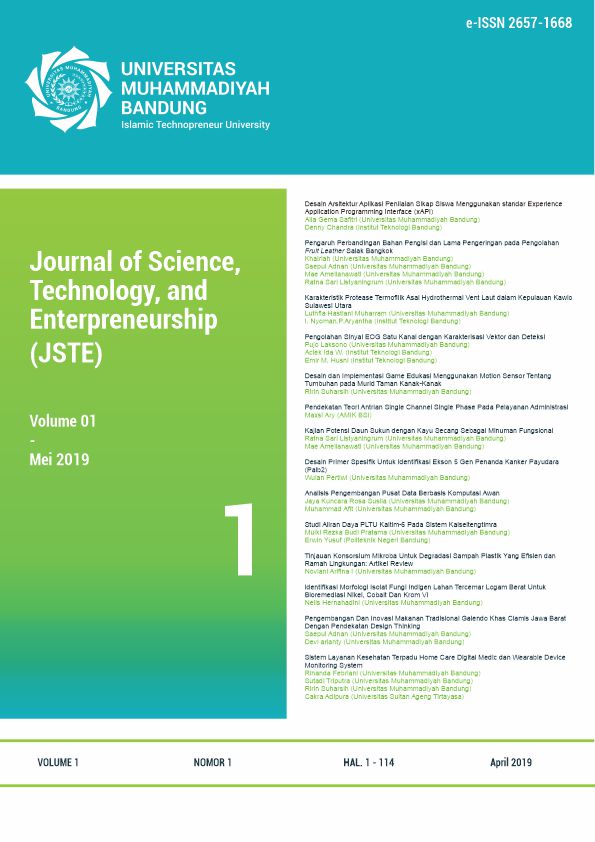Tinjauan Konsorsium Mikroba Untuk Degradasi Sampah Plastik Yang Efisien Dan Ramah Lingkungan: Artikel Review
Kata Kunci:
degradation of plastic waste, microbial consortiumAbstrak
The use of plastics for daily needs is increasing along with the times and population. The plastic waste has characteristics that are not easily biodegradable and require a very long decomposition time. This needs serious handling so that plastic waste does not accumulate and damage the environment. The burning method is not expected because it is less effective and produce negative effect for environment. Bacteria can be used to degrade plastic polymers into compounds that are easier to transport into cells to be used as carbon and energy sources. The use of microbial consortium can degrade plastic efficiency compared to the use of single bacterial isolates. This paper tries to review some of the results of research on environmentally friendly, efficient, and cost-effective management of plastic waste using microbial consortium.
Referensi
Agamuthu P, Tan YS, Fauziah SH (2013) Bioremediation of hydrocarbon contaminated soil using selected organic wastes. Procedia Environ Sci 18:694–702
Ainiyah DN, dan Shovitri M. (2014). Bakteri Tanah Sampah Pendegradasi Plastik dalam Kolom Winogradsky. Jurnal Sains dan Seni Pomits. 3(2): 63- 66
Akinde SB, Obire O (2008) Aerobic heterotrophic bacteria and petroleum-utilizing bacteria from cow dung and poultry manure. World J Microbiol Biotechnol 24:1999–2002
Alkaabi, S., van Geel, P.J. dan Warith, M.A (2009) Effect of saline water and sludge addition on biodegradation of municipal solid waste in bioreactor landfills. Waste Management & Research 27: 59–69
Anwar MS, Negi H, Zaidi MGH, Gupta S, Goel R (2013) Biodeterioration studies of thermoplastics in nature using indigenous bacterial consortia. Brazilian Arch Biol Technol 56: 475–484
Bhardwaj, H., Gupta, R., & Tiwari, A. (2012). Microbial population associated with plastic degradation. Scientific Reports, 5, 272–274.
Black, J. G. (2002) Microbiology. John Wiley & Sons, Inc.
Board NI (2006) The complete book on biodegradable plastics and polymers (recent developments properties, analyses, materials & processes). Asia Pacific Business Press, Delhi
Booth GH, Robb JA (2007) Bacterial degradation of plasticized PVC-effect on some physical properties. Int J Appl Chemi 18: 194–197
Chiellini E, Corti A, and D’Antone S (2007) Oxobiodegradable Full Carbon Backbone PolymersBiodegradation Behaviour of Thermally Oxidized Polyethylene in Aqueous Medium. Polymer Degradation and Stability. 92: 1378-1383.
Das MP and Kumar S (2013) Influence of Cell Surface Hydrophobicity in Colonization and Biofilm Formation on LDPE Biodegradation. Journal of Pharmacy and Pharmaceutical Sciences. 5 (4): 690-694.
Dey U, Mondal NK, Das K, Dutta S (2012) An approach to polymer degradation through microbes. IOSRPHR 2:385–388
Dian GM dan Pandebesie ES (2013) Pengaruh penambahan mikroorganisme terhadap kondisi operasi pemusnahan sampah plastik biodegradable. Jurnal Teknik POMITS Vol. 2, No. 1, ISSN: 2337-3539 (2301-9271 Print).
DudduMK, Tripura LK, Guntuku G, Divya DS (2015) Biodegradationof LDPE by a new bio-surfactant producing thermophillic
Streptomyces coelicoflavus NBRC 15399. Afr J Biotechnol 14: 327–340
Gall SC, Thompson RC (2015) The impact of debris on marine life. Marine Poll Bull 92:170–179
Geldreich EE, Nash HD, Reasoner DJ, Taylor RH (1972) The necessity of controlling bacterial populations in potable waters: community water supply. J Am Water Works Ass 64:596–602
Gilan I, Hadar Y, and Sivan A (2004) Colonization, Biofilm Formation and Biodegradation of Polyethylene by a Strain of Rhodococcus ruber. J. Appl Microbiol Biotechnol. 65: 97-104.
Gnanavel, G., JayaValli, M. V. P., Thirumarimurugan, M., & Kannadasan, T. (2012). Degradation of plastics using microorganisms. International Journal of Pharmaceutical and
Chemical Sciences, 1, 691–694.
Hadad D, Geresh S, and Sivan A (2005) Biodegradation of Polyethylene by The Thermophilic Bacterium Brevibacillus borstelensis. Journal of Applied Microbiology. 98: 1093-1100.
Hemashenpagam N, Growther L, Murgalatha N, Raj VS, Vimal SS (2013) Isolation and characterization of a bacterium that degrades PBSA. Int J Pharm Bio Sci 4:335–342
Howard GT, Hilliard NP (1999) Use of coomassie blue-polyurethane interaction in detection of polyurethanease proteins and polyurethanolytic bacteria. Int Biodeter Biodegr 43:23–30
John, R. C., Essien, J. P., Akpan, S. B.,&Okpokwasili, G. C. (2012). Polycyclic aromatic hydrocarbon-degrading bacteria from aviation fuel spill site at Ibeno, Nigeria. Bulletin of Environmental Contamination and Toxicology, 88, 1014–1019.
Kathiresan K (2003) Polythene and plastics-degrading microbes from the mangrove soil. Rev Biol Trop 51:629–633
Kyaw, B.M., Chmpakalakshmi, R., Sakharkar, M. K., Lim, C. S., & Sakharkar, K. R. (2012). Biodegradation of low density polythene (LDPE) by Pseudomonas species. Indian Journal of Microbiology, 52, 411–419.
Leja K and Lewandowicz G (2009) Polymer Biodegradation and Biodegradable Polymers-a Review. Polish J. of Environ. Stud. 19(2): 225-226.
Lucas, N., Bienaime, Ch., Belloy, Ch., Queneudec, M., Silvestre, F., Nava-Saucedo, J.E., (2008) Polymer biodegradation: mechanisms and estimation techniques: review, Chemosphere 73: 429-442.
Lü JC, Li ZT, Hussain K, Yang GK (2011) Bioremediation: the new directions of oil spill cleanup. Middle East J Sci Res 7:738–740
Magan N, Silvia F, Catarina B (2010) Environmental factors and bioremediation of xenobiotics using white rot fungi. Mycobiol 38:238–248
Mohan SK, and Srivastava T (2010) Microbial Deterioration and Degradation of Polymeric Materials. J. Biochem Tech. 2(4): 210-215
Mossel, D. A. A., Mengerink, W. H. J., & Scholts, H. H. (1962). Use of modified MacConkey agar medium for the selective growth and enumeration of Enterobacteriaceae. Applied Microbiology, 84, 235–240.
Nanda, S., Sahu, S. S., & Abraham, J. (2010). Studies on the biodegradation of natural and synthetic polyethylene by Pseudomonas spp. Journal of Applied Sciences and Environmental Management, 14, 57–60.
Nkwachukwu OI, Chima CH, Ikenna AO, Albert L (2013) Focus on potential environmental issues on plastic world towards a sustainable plastic recycling in developing countries. IJIC 4:1–13
Octavianda FT, Asri MT, Lisdiana L (2016) Potential of Oxo-Degradable Polyethylene-Degrading Bacteria of Benowo Landfill Soil Surabaya. Lentera Bio vol. 5 No. 1, Januari: 32-35
Page RD (2002) Visualizing phylogenetic trees using TreeView. Curr Protoc Bioinformatics. Chapter 6: Unit 6.2. doi: 10.1002/0471250953.bi0602s01
Rajendran S, Kannan VR, Natarajan K, Durai N, Kannan K, Chandru S, Arokiaswamy RA (2015) Environmental Waste Management, chapter: 12 The role of microbes in plastic degradation.
Razhiyafathima M, Praseetha PK, Rimal Isaac RS, (2016) Microbial Degradation of Plastic Waste: A Review, J Pharm Chem Biol Sci, June-August 2016;4(2):231-242
Saitou N, Nei M (1987) The neighbor-joining method: a new method for reconstructing phylogenetic trees. Mol Biol Evol 4:406–425
Shrivastava RS (2016) Our environment: challenges and solutions. Diamond Pocket Books Pvt Ltd.
Skariyachan S, Setlur AS, Naik SY, Naik AA, Usharani M, Vasist KS, (2017) Enhanced biodegradation of low and high-density polyethylene by novel bacterial consortia formulated from plastic-contaminated cow dung under thermophilic conditions. Environ Sci Pollut Res 24(9):8443-8457
Soni R, Kapri A, Zaidi MGH, Goel R (2009) Comparative biodegradation studies of non-poronized and poronized LDPE using indigenous microbial consortium. J Polym Environ 17:233–239
Tchobanoglous, G., Theisen, H. dan Vigil, S.A. (2003) Integrated Solid Waste Management, Engineering Principles and Management Issues. McGraw-Hill International Editions: New York.
Thomas BT, Olanrewaju-Kehinde DS, Popoola OD, James ES (2015) Degradation of plastic and polythene materials by some selected microorganisms isolated from soil. World Appl Sci J 33:1888–1891
Tribedi, P., Sarkar, S., Mukherjee, K., & Sil, A. K. (2012). Isolation of a novel Pseudomonas sp. from soil that can efficiently degrade polyethylene succinate. Environmental Science and Pollution Research, 19(6), 2115–2124.
Uchida, H., Nakajima-Kambe, T., Shigeno-Akutsu, Y., Nomura, N., Tokiwa, Y., & Nakahara, T. (2000). Properties of a bacterium which degrades solid poly (tetramethylene succinate)- co-adipate, a biodegradable plastic. FEMS Microbiology Letters, 189(1), 25–29.
Usha, R., Sangeetha, T., & Palaniswamy, M. (2011). Screening of polyethylene degrading microorganisms from garbage soil. Libyan Agriculture Research Center Journal International, 2, 200–204.
Vijayaraghavan P, Arun A, Al-Dhabi NA, Vincent SG, Arasu MV, Choi KC (2016) Novel Bacillus subtilis IND19 cell factory for the simultaneous production of carboxy methyl cellulase and protease using cow dung substrate in solid-substrate fermentation. Biotechnol Biofuels 9:1
Yadav A, Kumar A, Anupa M (2014) Retrospect and prospect of occupationally induced health hazards for plastic industry workers. Weekly Sci Res J 1:2321–7871
Zubris, K. A. V., & Richards, B. K. (2005). Synthetic fibers as an indicator of land application of sludge. Environmental Pollution, 138, 201–211.
Zuker M (2003) Mfold web server for nucleic acid folding and hybridization prediction. Nucleic Acids Res 31:3406–3415





